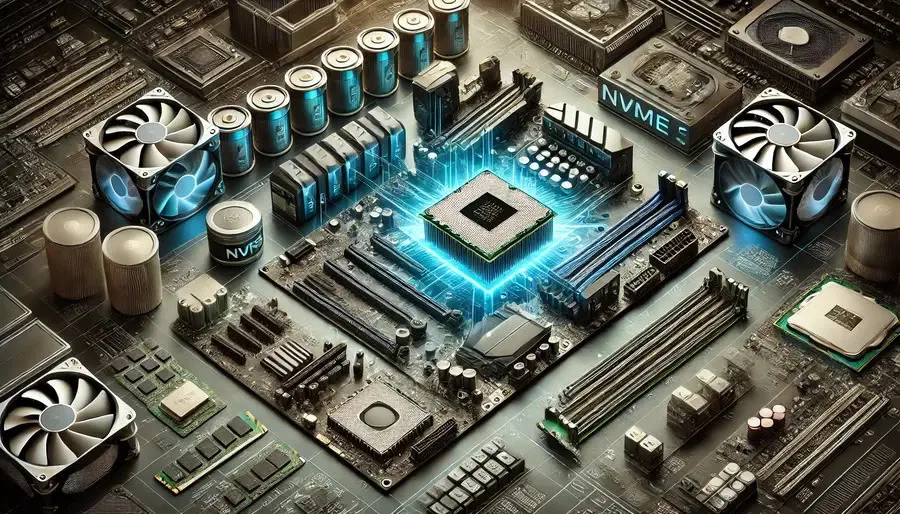
Trends and Novelties in the World of Computer Hardware
The landscape of computer hardware is in constant evolution, driven by technological advancements and increasing user demands. From cutting-edge processors to high-performance graphics cards, the innovations in computer hardware are shaping the future of computing. In this article, we explore the latest trends and novelties in processors, video cards, RAM, data storage, motherboards, and cooling and power solutions.
Processors
One of the most significant trends in the world of processors is the shift towards smaller manufacturing processes. Companies like Intel and AMD are moving towards 7nm and even 5nm technology nodes, which allow for greater efficiency and performance. These advancements result in faster processing speeds, improved multitasking capabilities, and lower power consumption.
The rise of multi-core processors is another key trend. Modern CPUs now feature upwards of 16 cores, providing unparalleled performance for demanding applications such as video editing, gaming, and 3D rendering. Additionally, the integration of AI and machine learning capabilities directly into the processors is becoming more prevalent, enhancing tasks such as real-time language translation and intelligent personal assistants.
Video Cards
Graphics processing units (GPUs) have seen remarkable advancements, particularly with the advent of ray tracing technology. This technology allows for more realistic lighting and shadows in computer graphics, significantly enhancing the visual experience in games and professional applications. Nvidia’s RTX series and AMD’s Radeon RX series are at the forefront of this revolution, offering impressive performance and new features.
Moreover, the increasing demand for 4K and VR gaming has driven the development of more powerful and efficient GPUs. These advancements not only cater to gamers but also to professionals in fields such as architecture, engineering, and media production, where high-resolution and real-time rendering are crucial.
RAM
The evolution of RAM has been marked by the transition from DDR4 to DDR5 memory. DDR5 offers significant improvements in speed and bandwidth, providing faster data transfer rates and improved energy efficiency. This upgrade is particularly beneficial for high-performance computing environments and gaming systems, where rapid data access is essential.
Another notable development is the increasing adoption of higher capacity modules. As applications and games become more demanding, systems with 32GB or even 64GB of RAM are becoming more common, ensuring smoother performance and better multitasking capabilities.

Data Storage
Solid-state drives (SSDs) continue to dominate the data storage market, with NVMe (Non-Volatile Memory Express) SSDs leading the charge. NVMe drives offer superior speed compared to traditional SATA SSDs, making them ideal for tasks that require rapid data access and transfer. This is especially important for gaming, content creation, and professional applications.
The trend towards higher storage capacities at lower costs is also noteworthy. Manufacturers are now offering consumer-grade SSDs with capacities up to 4TB, making it easier for users to store large amounts of data without compromising on speed. Additionally, advancements in storage technologies such as QLC (Quad-Level Cell) are driving down prices and increasing the availability of high-capacity drives.
Motherboards
Motherboards have evolved to support the latest CPU and GPU technologies, ensuring compatibility and optimal performance. The introduction of PCIe 4.0 and PCIe 5.0 standards has significantly increased data transfer speeds, benefiting high-speed storage solutions and powerful graphics cards.
Furthermore, the integration of advanced networking features like Wi-Fi 6 and 10Gb Ethernet is becoming standard in modern motherboards, providing faster and more reliable internet connections. Enhanced cooling solutions and support for more extensive and faster RAM configurations are also key features in the latest motherboard designs.
Cooling and Power
Efficient cooling and power management are critical for maintaining optimal performance and longevity of computer hardware. The trend towards more powerful and compact components necessitates advanced cooling solutions. Liquid cooling systems, both all-in-one (AIO) and custom loops, are becoming more popular due to their superior cooling capabilities and quieter operation compared to traditional air cooling.
In the realm of power supplies, the focus is on higher efficiency and modularity. Power supplies with 80 PLUS Gold and Platinum certifications offer improved energy efficiency, reducing heat output and energy consumption. Modular power supplies, which allow users to connect only the cables they need, improve airflow within the case and simplify cable management.
